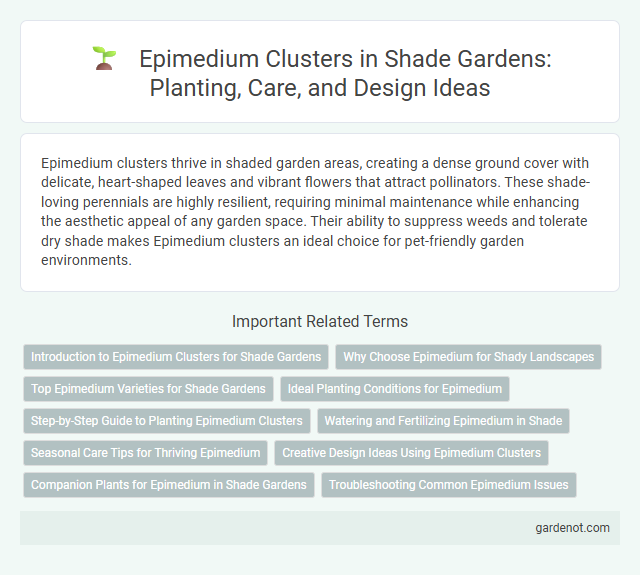Epimedium clusters thrive in shaded garden areas, creating a dense ground cover with delicate, heart-shaped leaves and vibrant flowers that attract pollinators. These shade-loving perennials are highly resilient, requiring minimal maintenance while enhancing the aesthetic appeal of any garden space. Their ability to suppress weeds and tolerate dry shade makes Epimedium clusters an ideal choice for pet-friendly garden environments.
Introduction to Epimedium Clusters for Shade Gardens
Epimedium clusters are ideal for shade gardens, thriving under deciduous trees where sunlight is filtered and moisture is retained. Known for their delicate, heart-shaped leaves and vibrant spring flowers, these perennial plants create a lush and textured ground cover that suppresses weeds naturally. Their drought tolerance and resistance to deer make Epimedium clusters a practical and attractive choice for low-maintenance shade garden landscapes.
Why Choose Epimedium for Shady Landscapes
Epimedium thrives in low-light environments, making it an ideal choice for shade gardens where many plants struggle. Its drought tolerance and deer resistance ensure longevity and low maintenance in shady landscapes. The plant's delicate, heart-shaped leaves and vibrant spring flowers add year-round aesthetic appeal to any shaded area.
Top Epimedium Varieties for Shade Gardens
Epimedium clusters thrive in shade gardens, providing vibrant foliage and delicate, colorful blooms ideal for low-light conditions. Top Epimedium varieties include Epimedium x versicolor 'Sulphureum' with its bright yellow flowers, Epimedium grandiflorum featuring large pink blossoms, and Epimedium perralchicum known for its coral-red flowers and robust growth in shaded environments. These varieties offer excellent ground cover, drought tolerance, and seasonal interest, making them essential for enhancing shade garden landscapes.
Ideal Planting Conditions for Epimedium
Epimedium thrives in shaded to partially shaded areas with well-draining, humus-rich soil that maintains consistent moisture without waterlogging. This perennial prefers slightly acidic to neutral pH levels, typically between 6.0 and 7.0, and benefits from organic mulch to regulate soil temperature and retain moisture. Ideal planting conditions include protected locations away from harsh afternoon sun and strong winds, ensuring healthy foliage and vibrant, delicate flowers.
Step-by-Step Guide to Planting Epimedium Clusters
Select a shaded area with well-draining soil and enrich it with organic matter before planting Epimedium clusters. Space the plants 12 to 18 inches apart to allow proper airflow and growth, and plant the clusters at the same depth they were growing in their nursery pots. Water thoroughly after planting and maintain consistent moisture while avoiding waterlogged conditions to encourage healthy root establishment and vibrant foliage.
Watering and Fertilizing Epimedium in Shade
Epimedium clusters thrive in consistently moist, well-drained soil, requiring regular watering to maintain hydration without waterlogging, especially in shaded garden areas. Fertilize Epimedium sparingly with a balanced, slow-release fertilizer in early spring to support steady growth and vibrant foliage. Applying organic mulch helps retain soil moisture and provides essential nutrients, enhancing overall plant health in shade conditions.
Seasonal Care Tips for Thriving Epimedium
Epimedium clusters thrive in well-drained, humus-rich soil with consistent moisture during the growing season, especially in spring and early summer. Apply a layer of mulch in late fall to protect roots from winter cold and conserve soil moisture. Pruning spent foliage in early spring before new growth emerges helps maintain plant health and encourages vigorous blooms.
Creative Design Ideas Using Epimedium Clusters
Epimedium clusters bring vibrant color and delicate texture to shade gardens, making them ideal for creative design ideas. Their heart-shaped leaves and small, intricate flowers create natural, flowing patterns that enhance garden depth and visual interest. Incorporating Epimedium in layered plantings or as ground cover under trees elevates shade garden aesthetics while offering low-maintenance beauty throughout the growing season.
Companion Plants for Epimedium in Shade Gardens
Epimedium clusters thrive alongside hostas, ferns, and astilbes, which complement their delicate foliage and vibrant spring blooms while enhancing shade garden texture. These companion plants share similar moisture and soil pH preferences, creating a cohesive, low-maintenance understory. Incorporating hellebores or shade-tolerant grasses can further diversify the garden's visual appeal and support seasonal interest year-round.
Troubleshooting Common Epimedium Issues
Epimedium clusters may suffer from common issues such as yellowing leaves caused by overwatering or poor drainage, and leaf spot diseases triggered by fungal infections in damp conditions. To troubleshoot, ensure well-drained soil with moderate moisture levels and remove affected foliage to prevent the spread of disease. Maintaining proper airflow and avoiding excessive humidity helps keep Epimedium plants healthy and vibrant in shade gardens.
Epimedium cluster Infographic

 gardenot.com
gardenot.com